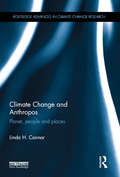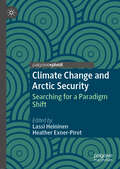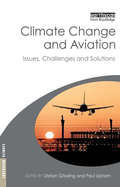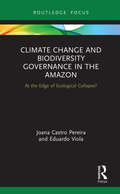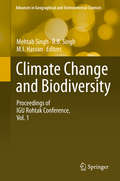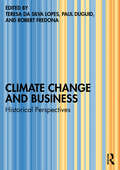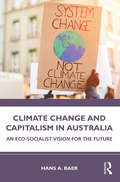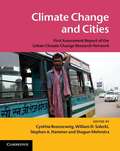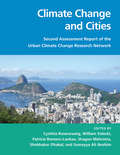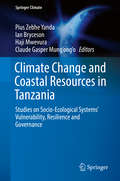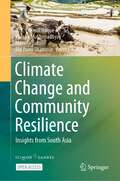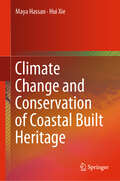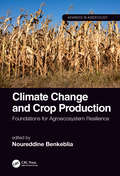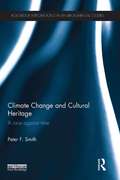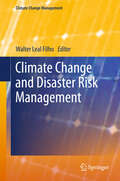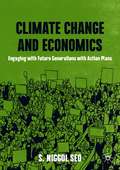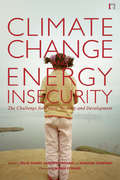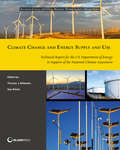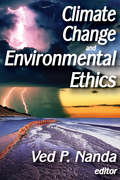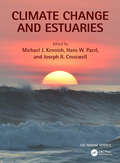- Table View
- List View
Climate Change and Animal Health (CRC One Health One Welfare)
by Colleen Duncan Craig StephenThis benchmark publication assembles information on the current and anticipated effects of climate change on animal health. It empowers educators, managers, practitioners, and researchers by providing evidence, experience, and opinions on what we need to do to prepare for, and cope with, the largest threat ever to have faced animals on this planet. With expert contributors from across the globe, the text equips the reader with information and means to develop sustainable adaptation or mitigation actions. After introducing animal health in a climate change context, chapters look at specific animal health impacts arising from climate change. The book concludes with suggestions on teachable and actionable ideas that could be used to mobilize concepts provided into education or advocacy. This book was written amid the COVID-19 pandemic and in the face of ever-increasing reports of on-the-ground, real-life climate impacts. Large scale wildfire and ocean heat waves killed unprecedented numbers of animals while droughts in some areas and floods in others displaced thousands of livestock and made food scarce for even more. Climate change is real, and it is here. How we respond will have profound implications for people, biodiversity, welfare, conservation, societies, economies and ecosystems. Today's veterinary educators are awakening to the need to adapt and train a new generation of animal health professions who can understand and plan for climate change, and this book is an essential resource.
Climate Change and Anthropos: Planet, people and places (Routledge Advances in Climate Change Research)
by Linda H. ConnorAnthropos, in the sense of species as well as cultures and ethics, locates humans as part of much larger orders of existence – fundamental when thinking about climate change. This book offers a new way of exploring the significance of locality and lives in the epoch of the Anthropocene, a time when humans confront the limits of our control over nature. Many scholars now write about the ethics, policies and politics of climate change, focussing on global processes and effects. The book’s innovative approach to cross-cultural comparison and a regionally based study explores people’s experiences of environmental change and the meaning of climate change for diverse human worlds in a changing biosphere. The main study site is the Hunter Valley in southeast Australia: an ecological region defined by the Hunter River catchment; a dwelling place for many generations of people; and a key location for transnational corporations focussed on the mining, burning and export of black coal. Abundant fossil fuel reserves tie Hunter people and places to the Asia Pacific – the engine room of global economic growth in the twenty-first century and the largest user of the planet’s natural resources. The book analyses the nexus of place and perceptions, political economy and social organisation in situations where environmental changes are radically transforming collective worlds. Based on an anthropological approach informed by other ways of thinking about environment-people relationships, this book analyses the social and cultural dimensions of climate change holistically. Each chapter links the large scales of species and planet with small places, commodity chains, local actions, myths and values, as well as the mingled strands of dystopian imaginings and strivings for recuperative renewal in an era of transition.
Climate Change and Arctic Security: Searching for a Paradigm Shift
by Lassi Heininen Heather Exner-PirotThis book assesses the construction of security in the context of climate change, with a focus on the Arctic region. It examines and discusses changes in the security premises of the Arctic states, from traditional security to environmental and human security. In particular, the book explores how climate change impacts security discourses and premises as well as theoretically discussing the possibility for another change, from circumpolar stability into peaceful change. Chapters cover topics such as the ethics of climate change in the arctic, China’s emerging power and influence on arctic climate security, the discursive transformation of the definition of security and the intersection between urban, climate and Arctic studies. The book concludes with the question of whether a paradigm shift in our understanding of traditional security is possible, and whether it is already occurring in the Arctic.
Climate Change and Armed Conflict: Hot and Cold Wars (Routledge Studies in Peace and Conflict Resolution)
by James R. LeeThis book examines the evolution of the relationship between climate change and conflict, and attempts to visualize future trends. Owing to the accumulation of greenhouse gases in the atmosphere, current trends in climate change will not appreciably alter over the next half century even if drastic action is taken now. Changes in climate will produce unique types and modes of conflict, redefine the value of important resources, and create new challenges to maintaining social order and stability. This book examines the consequences of climate change and argues that it has and will produce two types of different types of conflict: 'cold wars' and 'hot wars'. Cold wars will occur in northern and southern latitudes as warming draws countries into possible conflict due to expanding interests in exploiting new resources and territories (inter-state conflict). Hot wars will break out around the equator as warming expands and intensifies dry areas, increasing competition for scarce resources (intra-state conflict). Conflict is not inevitable, but it will also be a consequence of how states, international institutions and people react to changes in climate. Climate change and conflict have always shaped human experiences. This book lays out the parameters of the relationship, shows its history, and forecasts its trends, offering future conditions and opportunities for changing the historical path we are on. This book will be of great interest for students of climate change and environmental security, peace and conflict studies, and IR/security studies in general. James R. Lee is a Professor in the School of International Service, American University, Washington, DC and Associate Director of American University's Center for Teaching Excellence. He is author of several books on international relations, including, most recently, Exploring the Gaps: Vital Links Between Trade, Environment and Culture (2000).
Climate Change and Aviation: Issues, Challenges and Solutions (Earthscan Climate Ser.)
by Paul Upham Stefan Gösling'This is a timely, challenging and fascinating book on a topic of central importance to the success or otherwise of our climate change policies. It sets down a clear marker for what has to be done in the aviation sector.' Professor John Whitelegg, Stockholm Environment Institute, University of York, UK 'Climate Change and Aviation presents a clear picture of the transport sector's greatest challenge: how to reconcile aviation's immense popularity with its considerable environmental damage and its dependence on liquid hydrocarbon energy sources. This book avoids wishful thinking and takes the much harder, but more productive, path of considering difficult solutions that clash with short-term and short-sighted expectations about the unlimited growth potential for flying.' Professor Anthony Perl, Urban Studies Program, Simon Fraser University, Canada 'A convincing and timely collection that brings together an impressive range of expertise. The book integrates various perspectives into a powerful core argument - we must do something, and quickly, to tackle the impact of aviation on our environment. The authors recognise the political difficulties associated with promoting change but present constructive options for policy makers. Required reading, especially for transport ministers set on promoting the growth of air travel.' Professor Jon Shaw, Director of the Centre for Sustainable Transport, University of Plymouth, UK Trends such as the massive growth in availability of air travel and air freight are among those which have led to aviation becoming one of the fastest growing emitters of greenhouse gases. These trends have also caused a shift in expectations of how we do business, where we go on holiday, and what food and goods we can buy. For these reasons aviation is (and is set to stay) high up on global political, organizational and media agendas. This textbook is the first to attempt a comprehensive review of the topic, bringing together an international team of leading scientists. Starting with the science of the environmental issues, it moves on to cover drivers and trends of growth, socio-economics and politics, as well as mitigation options, the result being a broad yet detailed examination of the field. This is essential reading for undergraduate and postgraduate courses in transport, tourism, the environment, geography and beyond, while also being a valuable resource for professionals and policymakers seeking a clear understanding of this complex yet urgently pressing issue.
Climate Change and Biodiversity Governance in the Amazon: At the Edge of Ecological Collapse? (Routledge Advances in International Relations and Global Politics)
by Joana Castro Pereira Eduardo ViolaThis book provides an analysis of the recent governance of the Amazon in Brazil, Peru, Bolivia and Colombia with a particular focus on deforestation processes, demonstrating that current policies and political and socioeconomic dynamics in the four countries are risking the forest’s resilience. The authors examine and compare Amazonian politics and policies under different administrations, concentrating on the main actors, policies and dynamics that have affected the region, as well as on the institutional and political environment in which deforestation processes were embedded in different periods. Essentially, the book makes an analytical contribution towards a better understanding of the political, economic and social challenges confronting conservation policy in the Amazonian countries. Climate Change and Biodiversity Governance in the Amazon: At the Edge of Ecological Collapse? is essential reading for students and researchers in the fields of environmental studies and sustainability, Latin American studies, political science and international relations, as well as for policymakers and practitioners working in conservation and development.
Climate Change and Biodiversity: Proceedings of IGU Rohtak Conference, Vol. 1 (Advances in Geographical and Environmental Sciences)
by R. B. Singh Mehtab Singh M. I. HassanThe over-exploitation of important earth resources such as land and water has led to a number of environment-related problems the world over. At the same time, land-use change caused by various human activities has led to extinction of many plant and animal habitats and species. In this context, the relevance of biodiversity for human survival is becoming a major international political issue as scientific evidence builds on the global health implications of biodiversity loss. These issues are closely linked with the issue of climate change, as many of the health risks due to climate change are associated with rapid degradation of biodiversity. This present work focuses on holistic natural resource-based spatio-temporal planning, development, and management and considers them as essential to save the degraded ecosystem for sustainable resource management. Contributions are compiled in two volumes: 1. Climate Change and Biodiversity and 2. Landscape Ecology and Water Management. Geoinformatics along with its tools such as remote sensing and geographical information systems (GIS) have been used in assessing the results of various environmental problems both physical and social. The volume will be useful for geographers, geoscientists, hydrologists, landscape ecologists, environmentalists, engineers, planners and policy makers.
Climate Change and Business: Historical Perspectives
by Paul Duguid Robert Fredona Teresa da Silva LopesClimate change is the greatest market failure in world history and thus the most urgent challenge in the world of business for the foreseeable future. This book brings together experts to shed light on the historical impact of business on climate change and of climate change on business.The book shows how corporate responses to climate change emerged out of earlier environmental concerns, regulatory frameworks, and in many cases already established business strategies. Contributors to the book analyse the evolution of business strategies to navigate environmental challenges even before climate crisis was widely recognised as an urgent concern.The historical insights presented by this book will be essential reading for business historians, as well as students, scholars, and reflective practitioners with an interest in the environment, political economy, business strategy, and risk management.
Climate Change and Capitalism in Australia: An Eco-Socialist Vision for the Future
by Hans A. BaerRecognizing that climate politics has been an increasingly contentious and heated topic in Australia over the past two decades, this book examines Australian capitalism as a driver of climate change and the nexus between the corporations and Coalition and Australian Labor parties. As a highly developed country, Australia is punching above its weight in terms of contributing to greenhouse gas emissions despite rising temperatures, droughts, water shortages and raging bushfires, storm surges and flooding, and the bleaching of the Great Barrier Reef. Drawing upon both archival and ethnographic research, Hans Baer examines Australian climate politics at the margins, namely the Greens, the labour union, the environmental NGOs, and the grass-roots climate movement. Adopting a climate justice perspective which calls for "system change, not climate change" as opposed to the conventional approach of seeking to mitigate emissions through market mechanisms and techno-fixes, particularly renewable energy sources, this book posits system-challenging transitional steps to shift Australia toward an eco-socialist vision in keeping with a burgeoning global socio-ecological revolution. Accessibly written and including an interview with renowned comedian and climate activist Rod Quantock OAM, this book is essential reading for academics, students and general readers with an interest in climate change and climate activism.
Climate Change and Carbon Markets: A Handbook of Emissions Reduction Mechanisms
by Farhana YaminClimate change is an environmental problem of unprecedented complexity, not just in terms of its physical, social, economic and political impacts, but particularly in terms of the range of policy instruments being designed by countries to reduce greenhouse gas emissions. Climate Change and Carbon Markets aims to provide an accessible and practical guide to cutting edge market-based mechanisms which will reduce greenhouse gas emissions. This book is a guide for national and international policy-makers and industry professionals, who need to understand the carbon markets established pursuant to the Kyoto Protocol, one of the most complex agreements ever negotiated. The book sets out how carbon markets will function by explaining the rules, institutions and procedures of the Kyoto mechanisms, including: emissions trading, joint implementation (JI) and the Clean Development Mechanism (CDM). It also provides an in-depth explanation of the EU Emissions Allowance Trading Scheme, emerging mechanisms in the US and developing countries, and how these will link up. For policy-makers, researchers and scholars; industry practitioners, companies, market service providers, technical and legal consultants, NGOs and all stakeholder organizations engaged in the Kyoto markets, this is the authoritative and comprehensive practical guide to this rapidly evolving area. Contains the full text of the key European Union documents setting up the EU Emissions Allowance Trading Scheme and the Linking Directive.
Climate Change and Carbon Recycling: Surface Chemistry Applications (ISSN)
by K. S. BirdiClimate Change and Carbon Recycling: Surface Chemistry Applications describes the application of surface chemistry methods for carbon capture and recycling in relation to climate change and atmospheric CO2 levels. The text is suitable for online education, with both basic and educational descriptions of the climate change process and carbon recycling methods like the adsorption and absorption of CO2 on solids. This book leads to a better understanding of a complex phenomenon and highlight the importance of CO2 capture and sequestration for the future to enable the utilization of fossil fuels without contributing to atmospheric greenhouse gases.Features This unique volume specifically highlights the surface chemistry aspects of carbon capture and recycling (CCR) Fills the need for an online textbook edition, which provides a basic and educational description of the climate change process and carbon capture/recycling Describes the application of surface chemistry methods for carbon capture and recycling, such as adsorption/absorption of CO2 Discusses the importance of recycling in reducing and controlling the concentration of carbon dioxide in the air (420 ppm: 0.042%) Describes the importance of the technology related to carbon capture/recycling and sequestration (CCS) from fossil fuel energy plants as a means of CO2 control
Climate Change and Cities: First Assessment Report of the Urban Climate Change Research Network
by Cynthia Rosenzweig William D. Solecki Stephen A. Hammer Shagun MehrotraUrban areas are home to over half the world's people and are at the forefront of the climate change issue. The need for a global research effort to establish the current understanding of climate change adaptation and mitigation at the city level is urgent. To meet this goal a coalition of international researchers - the Urban Climate Change Research Network (UCCRN) - was formed at the time of the C40 Large Cities Climate Summit in New York in 2007. This book is the First UCCRN Assessment Report on Climate Change and Cities. The authors are all international experts from a diverse range of cities with varying socio-economic conditions, from both the developing and developed world. It is invaluable for mayors, city officials and policymakers; urban sustainability officers and urban planners; and researchers, professors and advanced students.
Climate Change and Cities: Second Assessment Report Of The Urban Climate Change Research Network
by Cynthia Rosenzweig Shagun Mehrotra Shobhakar Dhakal William Solecki Somayya Ali Ibrahim Patricia Romero-LankaoThe Urban Climate Change Research Network's Second Assessment Report on Climate Change in Cities (ARC3.2) is the second in a series of global, science-based reports to examine climate risk, adaptation, and mitigation efforts in cities. <P><P>The book explicitly seeks to explore the implications of changing climatic conditions on critical urban physical and social infrastructure sectors and intersectoral concerns. The primary purpose of ARC3.2 is to inform the development and implementation of effective urban climate change policies, leveraging ongoing and planned investments for populations in cities of developing, emerging, and developed countries. <P>This volume, like its predecessor, will be invaluable for a range of audiences involved with climate change and cities: mayors, city officials and policymakers; urban planners; policymakers charged with developing climate change mitigation and adaptation programs; and a broad spectrum of researchers and advanced students in the environmental sciences. Contains double the number of chapters as the First ARC3 Report, based on feedback from numerous climate conferences around the world and a survey of city experts and practitioners.<P> Includes many new topics, including urban ecology and biodiversity, environmental equity and justice, economics, finance, and the private sector, urban planning and design, urban solid waste, urban coastal zones, mitigation and adaptation, and housing and informal settlements.<P> All sectors from the First ARC3 Report have been thoroughly updated.
Climate Change and Climate Modeling
by J. David NeelinProvides students with a solid foundation in climate science, with which to understand global warming, natural climate variations, and climate models. As climate models are one of our primary tools for predicting and adapting to climate change, it is vital we appreciate their strengths and limitations. Also key is understanding what aspects of climate science are well understood and where quantitative uncertainties arise. This textbook will inform the future users of climate models and the decision-makers of tomorrow by providing the depth they need, while requiring no background in atmospheric science and only basic calculus and physics. Developed from a course that the author teaches at UCLA, material has been extensively class-tested and with online resources of colour figures, Powerpoint slides, and problem sets, this is a complete package for students across all sciences wishing to gain a solid grounding in climate science.
Climate Change and Coastal Resources in Tanzania: Studies on Socio-Ecological Systems’ Vulnerability, Resilience and Governance (Springer Climate)
by Pius Zebhe Yanda Ian Bryceson Haji Mwevura Claude Gasper Mung'Ong'OThis volume synthesizes research from a five year program supported by the Norwegian Agency for Development to assess how coastal communities in Tanzania can adapt to climate change impacts such as sea level rise, and better assert their rights to implement decisions regarding coastal resource management in the context of global climate change. Throughout ten chapters, the book deploys a holistic approach to adopt a conceptual model of socio-ecological systems, and characterize human-nature interactions in an integrative way to understand anthropogenic pressures on ecosystems to guide conservation and management. The book will be of interest to researchers, students studying environmental management and climate change, planners, and policy makers. The book begins by describing the biophysical and socio-economic characteristics of the Tanzanian coastal environment, then discusses the impacts of climate change on coastal resource governance, community vulnerability, and livelihood security. Then, intervention strategies are offered as a means for local communities to not only adapt to climate change impacts, but also to engage in decision-making processes to assess vulnerabilities and address challenges and limitations through educated measures. The final chapters discuss the vulnerability and adaptation of coastal communities to climate change impacts to assess how livelihoods are constructed in response to impacts, and summarize the key findings to determine the best adaptation strategies to improve adaptive capacity and reduce socio-economic vulnerability.
Climate Change and Community Resilience: Insights from South Asia
by Pranab Mukhopadhyay A. K. Enamul Haque Mani Nepal Md Rumi ShamminThis open access book documents myriads of ways community-based climate change adaptation and resilience programs are being implemented in South Asian countries. The narrative style of writing in this volume makes it accessible to a diverse audience from academics and researchers to practitioners in various governmental, non-governmental and international agencies. At a time when climate change presents humanity with a gloomy future, the stories of innovation, creativity, grassroots engagement and locally applicable solutions highlighted in this book provides insights into hopeful ways of approaching climate solutions. South Asian countries have been dealing with the impact of climate change for decades and thus offer valuable learning opportunities for developing countries within and beyond the region as well as many western countries that are confronting the wrath of climate induced natural disasters more recently.SANDEE has been a pioneer in the development of research and training in environmental economics and related issues in South Asia and Prof Maler has been throughout SANDEE's history, its mentor, and its strongest supporter. Many young economists in South Asia have significantly benefited from Prof Maler's guidance and inputs. The present volume on “Climate Change and Community Resilience: Insights from South Asia” is a fitting tribute and an excellent reflection of Prof Maler's contributions to the SANDEE programme throughout his association.- Mahesh Banskota, Ph.D.Professor, Development StudiesSchool of Arts, Kathmandu UniversityThis comprehensive volume aptly identifies grassroots initiatives as the core of the problem of adaptation to climate change. The analysis of the different experiments is lucid, inclusive, and full of interesting detail. The methodologies used and the subjects covered span a range of frameworks and narratives. Put together, the studies are a fitting tribute to Karl-Goran Maler, who spent years putting his impeccable expertise to use for the cause of enhancing research in South Asia.- Kanchan Chopra, Ph.D.Former Director and Professor, Institute of Economic Growth, Delhi, and Fellow, SANDEEThe slow international policy response to climate change elevates the importance of understanding how communities can respond to climate change’s many threats. This unusually accessible volume provides that understanding for South Asia while being relevant to the rest of the world. Its emphasis on research by scholars from the region makes it a wonderful tribute to Prof. Karl-Göran Mäler, who contributed so much to the growth of environmental economics research capacity in South Asia.- Jeffrey R. Vincent, Ph.D.Clarence F. Korstian Professor of Forest Economics & ManagementNicholas School of the Environment, Duke University, USA
Climate Change and Conservation of Coastal Built Heritage
by Maya Hassan Hui XieThis book presents the preservation principles and the current environmental challenges relating to monitoring heritage sites and buildings under the effects of climate change. It provides a clear overview of conservation action levels and the importance of participation and cooperation between them, and discusses evaluation and management methods, thermal comfort for the common usages, and conceptual methods for enhancing the built heritage. The research presented employed the “Zoom In, Zoom Out” approach for monitoring the Syrian coastal heritage sites threatened by the direct and indirect effects of climate change. Lastly, the book establishes the basic principles and conservation strategies for preserving the coastal heritage sites and buildings. As such, it is a valuable reference resource for researchers, developers, architects, and conservators involved in protecting the architectural heritage in coastal areas. It can also be used as a guidebook on preserving and monitoring built heritage sites at both macro and micro levels.
Climate Change and Crop Production: Foundations for Agroecosystem Resilience (Advances in Agroecology)
by Noureddine BenkebliaPresenting an overview of agroecology within the framework of climate change, this book looks at the impact of our changing climate on crop production and agroecosystems, reporting on how plants will cope with these changes, and how we can mitigate these negative impacts to ensure food production for the growing population. It explores the ways that farmers can confront the challenges of climate change, with contributed chapters from around the world demonstrating the different challenges associated with differing climates. Examples are provided of the approaches being taken right now to expand the ecological, physiological, morphological, and productive potential of a range of crop types. Describes the effects and responses of the macro and micro levels of crops under the different components of climate change Reports on the adaptation and resilience of food production systems within the changing climate Covers how plants cope with the changing climate including physiological, biochemical, phenotype, and ecosystem responses Provides an in-depth discussion on the importance of agricultural education connected to climate change Giving readers a greater understanding of the mechanisms of plant resilience to climate change, this book provides new insights into improving the productivity of an individual crop species as well as bringing resistance and resiliency to the entire agroecosystem. It offers a strong foundation for changing research and education programs so that they build the resistance and resilience that will be needed for the uncertain climate future ahead.
Climate Change and Cultural Heritage: A Race against Time (Routledge Explorations in Environmental Studies)
by Peter F. SmithHistory reveals how civilisations can be decimated by changes in climate. More recently modern methods of warfare have exposed the vulnerability of the artefacts of civilisation. Bringing together a range of subjects - from science, energy and sustainability to aesthetics theory and civilization theory - this book uniquely deals with climate change and the ensuing catastrophes in relation to cultural factors, urbanism and architecture. It links the evolution of civilisation, with special emphasis on the dynamics of beauty as displayed in architecture and urbanism, to climate change. It then considers both the historic and predicted impacts of climate change and the threat it poses to the continued viability of human civilisation when survival is the top priority. This book gives students, researchers and professionals in architecture and sustainable design as well as anyone interested in the threat of global warming to civilisation, new insights as to what could be lost if action is not taken at a global level.
Climate Change and Disaster Risk Management (Climate Change Management #0)
by Walter Leal FilhoThere has been some degree of reluctance in the past to consider disaster risk management within the mainstream of adaptation to climate variability and climate change. However, there is now wide recognition of the need to incorporate disaster risk management concerns in dealing with such phenomena. There is also a growing awareness of the necessity for a multi-sectoral approach in managing the effects of climate variability and climate change, since this can lead to a significant reduction of risk. This book presents the latest findings from scientific research on climate variation, climate change and their links with disaster risk management. It showcases projects and other initiatives in this field that are being undertaken in both industrialised and developing countries, by universities and scientific institutions, government bodies, national and international agencies, NGOs and other stakeholders. Finally, it discusses current and future challenges, identifying opportunities and highlighting the still unrealised potential for promoting better understanding of the connections between climate variation, climate change and disaster risk management worldwide.
Climate Change and Economics: Engaging with Future Generations with Action Plans
by S. Niggol SeoThis textbook provides a broad introduction to the relationship between climate change, economics, and climate policy for young readers and future generations. It highlights the problem of intergenerational gaps and burden sharing on climate change. Taking on major contentious issues of today, it is rich with behavioural strategies and real life experiences which are explained in an accessible and engaging way. A diverse range of topics are covered, including farm animals of Sub-Sahara, Latin American rainforests, Indian monsoon agriculture, tropical cyclones in Bangladesh, sublime grasslands, energy revolutions, hydroelectric dams of China, backstop technologies, ocean exchanges with the atmosphere, mass extinction of species, commercial fisheries, infectious diseases and pandemics, and a climate policy big deal. Climate Change and Economics: Engaging with Future Generations with Action Plans aims to engage with young readers and offer action plans for activists. It is relevant to students interested in environmental economics and environmental science.
Climate Change and Energy Insecurity: The Challenge for Peace, Security and Development
by Richard Sherman Felix DoddsClimate change is now recognised as one of the greatest challenges facing the international community and when coupled with energy production and use - the most significant contributor to climate change - and the related security problems the double threat to international security and human development is of the highest order. This wide-ranging book brings together leading thinkers from academia, government and civil society to examine and address the global insecurity and development challenges arising from the twin thrust of climate change and the energy supply crunch. Part one considers energy. It analyses the challenges of meeting future energy demands and the ongoing and future security-related conflicts over energy. Coverage includes security and development concerns related to the oil and gas, nuclear, bio-fuels and hydropower sectors, ensuring energy access for all and addressing sustainable consumption and production in both developed and rapidly industrializing countries such as India, China, Brazil and South Africa. Part two analyses how climate change contributes to global insecurity and presents a consolidated overview of the potential threats and challenges it poses to international peace and development. Coverage includes future water scenarios including a focus on scarcity in the Middle East, food security, biodiversity loss, land degradation, the changing economics of climate change, adaptation and the special case of small island states. The final part lays out the potential avenues and mechanisms available to the international community to address and avert climate and energy instability via the multilateral framework under the United Nations. It also addresses mechanisms for resource and knowledge transfer from industrialized to developing countries to ensure a low-carbon energy transition by focusing on the rapid deployment of clean energy technologies and ways to tackle income and employment insecurity created by the transition away from traditional energy sources. This book offers the most comprehensive international assessment of the challenges and solutions for tackling the global insecurity arising from climate change and energy provision and use. It is essential reading for students, researchers and professionals across international relations, security, climate change and the energy sectors.
Climate Change and Energy Supply and Use: Technical Report for the U.S. Department of Energy in Support of the National Climate Assessment (NCA Regional Input Reports)
by Thomas J. WilbanksDeveloped to inform the 3rd National Climate Assessment, and a landmark study in terms of its breadth and depth of coverage and conducted under the auspices of the U. S. Department of Energy, Climate Change and Energy Supply and Use examines the known effects and relationships of climate change variables on energy production and supply, including oil, gas, thermal electricity, and renewable energy. Knowledge of today's available energy forms is constantly surfacing and changing in the face of climate change, making it increasingly important to enhance communication about various energy supplies. This report on energy supply and use summarizes current knowledge, especially emerging findings, about implications of climate change for energy production and supply (oil and gas, thermal electricity, renewable energy, integrated perspectives, and indirect impacts on energy systems). A comprehensive resource for community planners and researchers, it discusses future risk-management strategies surrounding water treatment, heating or cooling, and mitigation that the country can utilize in its energy consumption. The authors analyze findings from their own research and practice to arrive at conclusions about vulnerabilities, risks, and impact concerns for different aspects of U. S. energy supply and use. Global and national policy contexts are informed by these efforts to create energy options and choices. Rich in science and case studies, Climate Change and Energy Supply and Use offers decision makers and stakeholders a substantial basis from which to make informed choices that will affect energy risk-management in the decades to come.
Climate Change and Environmental Ethics
by David ShakowThere is a broad consensus that climate change presents the international community with a formidable challenge. Yet progress on all fronts-prevention, mitigation, and adaptation-has been slow. Ved P. Nanda finds an explanation for this disparity in the sharp divide between the developed and developing countries. Developing countries demand that major industrialized nations provide the necessary resources and technology to address climate change, while many developed countries seek firm commitments and timetables on action from the developing countries. The result is a stalemate. Climate Change and Environmental Ethics contains first-rate research and thinking from scholars from multiple disciplines-ethics, ecology, philosophy, economics, political science, history, and international law. What distinguishes this volume from recent work on climate change are two of its special features. One is the multi-disciplinary backgrounds of the scholars, their stellar experiences, and the wisdom with which they express not simply their philosophy and theory but also their suggestions for concrete, specific action in practical terms. The second is the special niche this volume fills in its overarching theme of the need for a renewed environmental ethic that can bring together these disparate but interconnected views. This volume explores alternative ways of conceiving our relation to the natural world. A spirit of international cooperation and collaboration is needed to meet the challenge. The reader is complelled to think anew about our understanding of the scientific and technical issues, as well as our values and ethical responsibilities regarding climate change.
Climate Change and Estuaries (CRC Marine Science)
by Michael J. Kennish, Hans W. Paerl, and Joseph R. CrosswellClimate change is having an increasing impact on coastal, estuarine, and marine environments worldwide. This book provides state-of-the-art coverage of climate change effects on estuarine ecosystems from local, regional, and global perspectives. With editors among the most noted international scholars in coastal ecology and estuarine science and contributors who are world-class in their fields, the chapters in this volume consist of comprehensive studies in coastal, estuarine and marine sciences, climate change, and coastal management and provide an extensive international collection of data in tabular, illustrated, and narrative formats useful for coastal scientists, planners, and managers. Comprised of three sections: (1) physical-chemical aspects; (2) biological aspects; and (3) management aspects, the book not only examines climatic and non-climatic drivers of change affecting coastal, estuarine, and marine environments but also their interactions and effects on populations of organisms, communities, habitats, and ecosystem structure and function. Pulling together today’s most salient issues and key literature advances for those concerned with coastal management, it allows the reader to see across direct and indirect interactions among disciplinary and ecosystem boundaries. Climate Change and Estuaries meets the research needs of climate scientists, estuarine and marine biologists, marine chemists, marine geologists, hydrologists, and coastal engineers, while students, professors, administrators, and other professionals will also find it an exhaustive reference.

